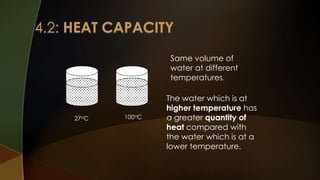Heat
- 1. PHYSICS FORM 4 MRSM KUALA KLAWANG
- 3. When you touch the hot pot what do you feel? High temperature High heat
- 4. Heat is a form of energy being transferred from a hot body to a cold body. The total amount of heat in a body depends on the mass, material and temperature of the body.
- 5. Temperature is a measure of the degree of hotness of a body. A hot body has a high temperature whereas a cold body has a low temperature.
- 6. TEMPERATURE HEAT The degree of hotness of a body A form of energy Base quantity Derived quantity Unit: kelvin (K) or degree celcius (oC) Unit : joule (J) Can be measured using the thermometer. No specific measuring equipment.
- 7. 4.1: UNDERSTANDING THERMAL EQUILIBRIUM Thermal equilibrium Liquid in glass thermometer 4.2: UNDERSTANDING SPECIFIC HEAT CAPACITY Specific heat capacity Applications 4.3: UNDERSTANDING SPECIFIC LATENT HEAT 4.4: UNDERSTANDING THE GAS LAWS Boyle’s Charles’ Pressure
- 8. Which has a higher temperature ? : A steaming cup of tea or a huge iceberg? The answer is obvious -- the tea is at a higher temperature. But which of the two has more heat?
- 9. The total amount . of heat in a body depends on the mass, material and temperature of the body
- 11. Energy is transferred at a faster rate from the hotter object # 1 to the cooler object #2. Energy is transferred at a slower rate from the cooler object # 2 to the hotter object # 1. The hot object loses energy while the cold object gains energy.
- 12. This causes the hot object to cool down while the cold object warms up. After some time, the rates of energy transfer between the two objects become equal. The two objects in thermal equilibrium have the same temperature
- 13. After some time, the rates of energy transfer between the two objects become equal. energy There is no net heat transfer between the two objects. The two objects are said to be in Thermal equilibrium.
- 14. When raw food, e.g. meat is put in the oven, heat from the oven is transferred to it. This process will continue until thermal equilibrium is reached between the food and the oven. Electric oven / microwave oven The temperature of the food and the oven will be the same when the food is cooked.
- 15. When food are kept in the refrigerator, the heat from the food is released to the cold air in the fridge. This process continues until thermal equilibrium is reached between the food and the fridge. The temperature of the food will be equal to the temperature of the fridge. refrigerator Hence the food are maintained in good condition
- 16. The thermometer is placed below the tongue, so that the thermometer is in contact with the mouth and tongue of the patient. Heat will flow from the patient’s tongue to the bulb of the thermometer After about a minute, thermal equilibrium is reached between the thermometer and the patient’s tongue/body. Taking the temperature of a sick person Therefore, the temperature reading shows the body temperature of the patient.
- 19. Heat will flow from the tongue to the bulb ,and this process will continue until TE is reached. The thermometer reading shows the body temperature.
- 20. Same volume of water at different temperatures. 27oC 100oC The water which is at higher temperature has a greater quantity of heat compared with the water which is at a lower temperature.
- 21. HOT WATER glass jug Hot water in both the glass and the jug. The water in the jug is hotter to touch compared to the water in the glass. The water in the jug has a greater quantity of heat compared to the water in the glass, because the water in the jug has a greater mass.
- 22. Iron plate Mica plate An iron plate and a mica plate of the same mass are put into the oven. After half a minute , the iron plate has a greater increase in temperature compared to the mica plate. This shows that heat absorbed is dependent on the type of materials.
- 23. 2 factors affecting heat capacities… i) ________________________ ii) ________________________ Specific Heat capacity: the amount of heat required to increase the temperature of 1 kg of a substance by 10C.
- 24. Amount of heat , q (joule) MASS, m (KILOGRAM) CHANGE IN TEMPERATURE, Дθ (0C ) SPECIFIC HEAT CAPACITY, c c = Q___ m Δθ Unit : J kg-1 0C-1
- 25. The sparks of a sparkler do not burn the hand of a person. However if the person touches the glowing part of the sparkler, he/she will get burn. sparkler This because the sparks have a smaller amount of heat compared to the glowing sparkler
- 26. A bowl of vegetable soup is too hot to drink. However, the vegetable in the soup can be eaten slowly although the soup and the vegetables are of the same temperature. A bowl of vegetable soup Why?


























